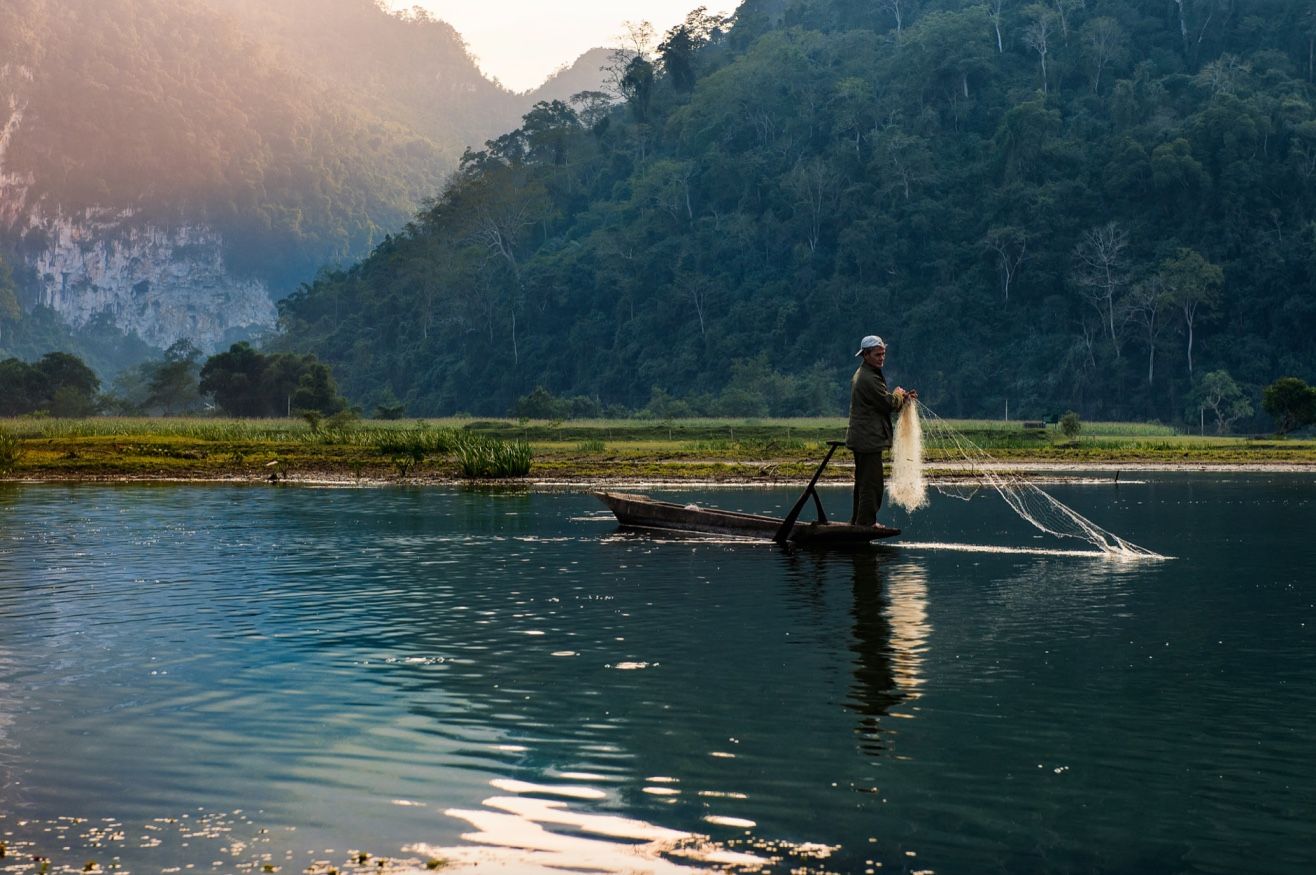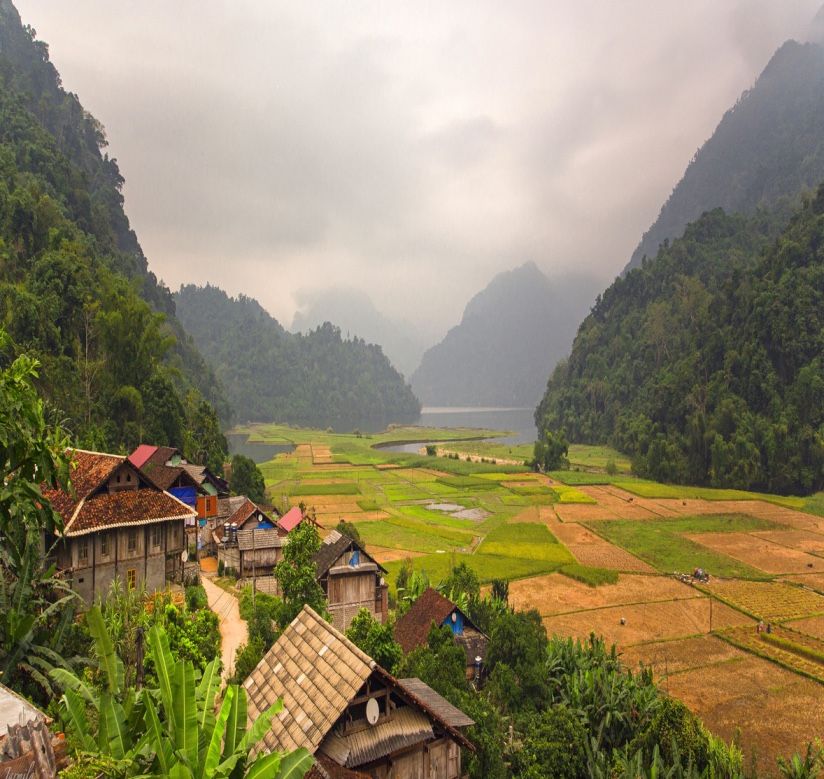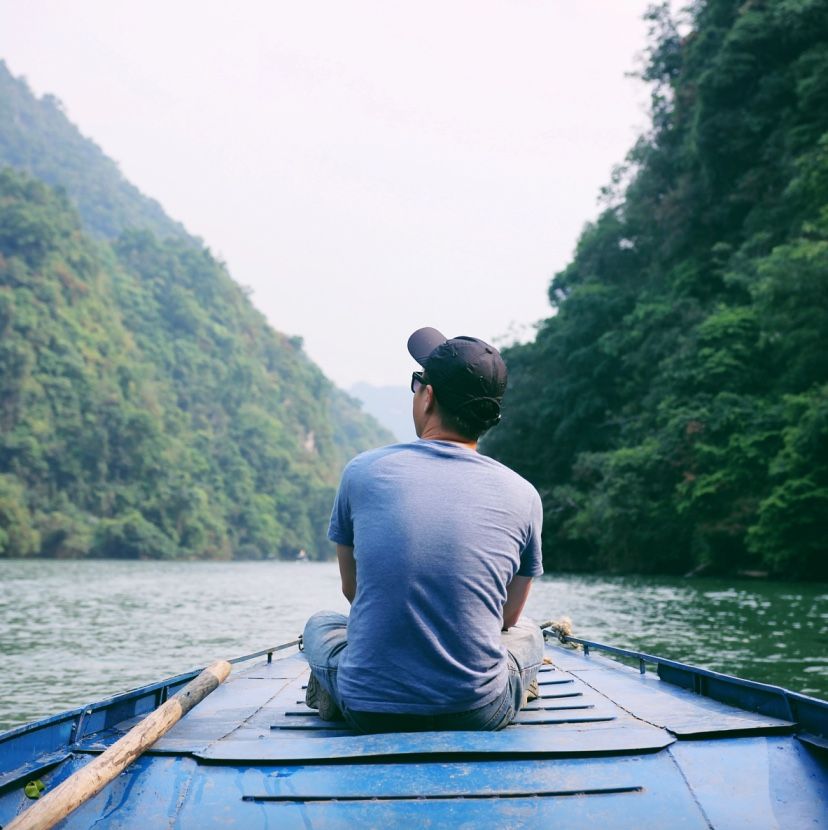Ba Be National Park: 10 Highlights & Travel Guide
Often referred to as Ba Be Lakes, Ba Be National Park, is in Bac Kan province and was established in 1992 as Vietnam’s eighth national park. It really is a babe: a beautiful region that covers more than 7000 hectares and boasts mountains high, rivers deep, waterfalls, plunging valleys, lakes and caves set amid towering peaks. The surrounding area is home to members of the Tay minority, who live in stilt homes.
The exceptional biodiversity, culture richness is what Ba Be National Park is known for, the area is also home to local ethnic minority villages. The serene environment offers a perfect escape from the hustle and bustle of city life. Nature enthusiasts and adventure seekers can enjoy a variety of activities, including jungle treks, cave explorations, and peaceful boat rides on Ba Be Lake, making it a top destination for those seeking both natural beauty and cultural experiences. Check out best Vietnam tours
An Introduction to Ba Be National Park?
The park is a tropical-rainforest area with over 550 named plant species, and the government subsidises the villagers not to cut down the trees. The 300 or so wildlife species in the forest include 65 (mostly rarely seen) mammals, 214 bird species, butterflies and other insects. Hunting is forbidden, but villagers are permitted to fish.
Flora & Fauna
Ba Be National Park is a rich biodiversity hub, featuring diverse ecosystems such as limestone and evergreen forests. The park supports a range of unique species, including Chinese pangolins, rhesus macaques, and François’ langurs. Birdwatchers will enjoy spotting over 230 bird species, while reptiles like the king cobra and Vietnamese salamander also inhabit the park. With 106 recorded fish species and an impressive 354 species of butterflies, the park’s vast natural diversity makes it an alluring destination for nature enthusiasts.
Ba Be Lake
Ba Be Lake, located at the heart of National Park, is Vietnam’s largest natural lake, formed over 200 million years ago. The name “Ba Be” translates to “Three Lakes,” as the lake consists of three distinct sections. Encircled by towering limestone cliffs and ancient forests, the lake provides a serene setting for boat rides, kayaking, and exploring hidden caves and waterfalls.
Tribal culture
Ethnic minority groups, mainly the Tay, Dao, and H’mong people, inhabit the park. These communities live in traditional stilt houses and preserve their rich cultural traditions, such as festivals, farming methods, and handicrafts. Visitors to the park can immerse themselves in authentic cultural exchanges and gain insights into the local way of life, especially when staying in homestays.
Best Highlights & Sights of Ba Be National Park
The park is surrounded by steep mountains, up to 1554m in height. Ba Be (Three Bays) is in fact three linked lakes, which have a total length of 8km and a width of about 400m. The deepest point in the lakes is 35m, and there are nearly 50 species of freshwater fish.
1. The Ba Be Lake
Ba Be Lake stands as the park’s main attraction, inviting visitors to explore its beauty on boat trips. The lake’s calm waters mirror the towering limestone cliffs, creating a breathtaking and peaceful scene. These boat journeys often lead to nearby landmarks such as Puong Cave and Dau Dang Waterfall, adding adventure to the experience.
2. Ethnic minority Villages
- Pac Ngoi Village features traditional Tay stilt houses, offering an immersive cultural experience.
- Bo Lu Village, home to the H’mong people, is renowned for its weaving, where visitors can observe skilled artisans and find handcrafted souvenirs.
- Ban Cam Village, nestled by the lake, provides the perfect setting for sunset boat rides with stunning panoramic views.
3. Tat Ma Waterfall
Tat Ma, often called the “Cloud Cascade,” offers an adventurous escape for those willing to take on a challenging two-hour hike. Towering at 15 meters, this secluded waterfall is surrounded by lush greenery, making it a perfect spot for a refreshing swim.
4. Dau Dang Waterfall
The Nang River’s crystal-clear waters rush over limestone rocks, forming a stunning cascade with natural pools. A scenic 30-minute hike through dense jungle leads to this peaceful spot, ideal for swimming or unwinding in nature.
5. The Puong Cave
Puong Cave, a striking tunnel carved by the Nang River, stretches 300 meters in length and rises 30 meters high. Inside, thousands of bats reside among breathtaking stalactites and stalagmites. A boat ride through the cave provides a peaceful journey beneath the towering rock formations.
6. Tham Phay Cave
Thrill-seekers tourists will find Tham Phay Cave an exciting challenge. Reaching it requires swimming and light climbing, leading through rugged landscapes for a truly off-the-beaten-path adventure.
7. Hau Ma Cave
Hua Ma Cave, stretching over 300 meters, stands out for its fascinating legends and striking stalactite formations. Inside, the cool, quiet ambiance creates a serene escape, while the towering stalactites resemble temples and pagodas, enhancing its mystical charm.
Best things to do in Ba Be National Park
Ba Be National Park, a breathtaking destination in northern Vietnam, features Ba Be Lake—the country’s largest freshwater lake—along with diverse ecosystems. Travelers can explore dense jungles, visit ethnic villages, and embark on countless adventures. Here’s a guide to the best activities in Ba Be National Park, along with tips to enhance your experience.
Two of the lakes are separated by a 100m-wide strip of water called Be Kam, sandwiched between high walls of chalk rock. The Thac Dau Dang (Dau Dang or Ta Ken Waterfall) consists of a series of spectacular cascades between sheer walls of rock, and is accessible by boat and on foot during day trips. Just 200m below the rapids is a small Tay village called Hua Tang. It costs 400, 000d for a boat here and takes at least four hours.
1. Boat Tour Over Ba Be Lake
Exploring Ba Be Lake by boat is an essential experience in Ba Be National Park. As you glide across its tranquil waters, limestone cliffs and untouched forests create a breathtaking backdrop. Many boat tours include stops at Puong Cave and Dau Dang Waterfall, offering a scenic and immersive way to discover the park.
Travel Tip: Opt for a private boat for a quieter, more personal trip, and bring a camera to capture the lake’s stunning reflections.
2. Jungle trekking
Trekking through Ba Be National Park is an incredible way to experience its diverse landscapes, with trails suited for all skill levels. Hike to An Ma Temple for a cultural experience, venture through dense rainforest to reach Dau Dang Waterfall, or take on the challenge of trekking to Khau Quan for breathtaking views. Along the way, explore hidden caves, encounter ethnic villages, and take in the park’s stunning scenery.
Travel Tip: For longer or more challenging treks, hiring a local guide ensures you stay on the right path and get the most out of your adventure.
3. Caving experience
Ba Be National Park boasts an exciting network of caves, each offering a unique experience. For a true adventure, dive into Tham Phay Cave, a river cave that requires swimming and squeezing through narrow passages. If you prefer a more accessible option, take a boat ride through Puong Cave, where thousands of bats roost among towering stalactites beneath a limestone arch. Check out famous caves in Vietnam
Travel Tip: Bring waterproof gear and a reliable flashlight for cave exploration. For a more intense adventure, join a guided Tham Phay Cave tour, where helmets and headlamps are provided for safety.
4. Kayaking on Ba Be Lake
Kayaking on Ba Be Lake offers a tranquil way to immerse yourself in the park’s natural beauty. Paddle at your own pace, drifting past limestone cliffs, weaving through jungle-fringed waterways, and uncovering hidden spots around the lake.
5. Cycling Through the National Park
Cycling through Ba Be National Park offers a scenic and rewarding way to explore its quiet roads. Ride past lush forests, charming ethnic villages, and flowing streams while taking in breathtaking landscapes. Popular routes lead to Hua Ma Cave, or, Thac Bac Waterfall, and surrounding villages, allowing you to see more in a day than on foot.
Travel Tip: Rent a sports bike locally and start early to avoid midday heat. Bring plenty of water and snacks for the journey!
6. Swimming in Ba Be Lake
Taking a dip in Ba Be Lake’s cool, clear waters is a refreshing way to unwind after a hike or boat trip. Several scenic spots around the lake offer safe swimming areas, where you can float while enjoying breathtaking mountain views. The peaceful atmosphere makes it a perfect escape into nature.
Travel Tip: Stick to designated swimming areas for safety. The water stays cool year-round, providing a refreshing break, especially during the summer months.
7. Local homestay experience
For a truly local and authentic experience, spend the night in a homestay around Ba Be Lake. Run by Tay families, these traditional stilt houses provide cozy accommodations with stunning views of the lake or mountains. Guests can enjoy home-cooked meals made with fresh, local ingredients and gain insight into the Tay people’s culture and traditions.
Travel Tip: Many homestays serve family-style dinners, perfect for meeting other travelers while enjoying authentic Vietnamese cuisine. For added comfort, choose a homestay with modern amenities like private bathrooms and hot showers.
8. Visit ethnic minority villages
Several ethnic minority groups, including the Tay, Dao, and H’mong, live in Ba Be National Park. Villages like Pac Ngoi, Bo Lu, and Ban Cam provide a window into their daily lives, showcasing traditional stilt houses, weaving, and fishing techniques.
Travel Tip: Show respect for local customs, and for a deeper cultural experience, stay in a village homestay.
How to get from Hanoi to Ba Be National Park
Reaching Ba Be National Park requires some planning, as no direct buses serve this remote northern Vietnam destination. Here are the best ways to get there:
1. Limousine Van
Traveling to Ba Be National Park in a limousine van from Hanoi offers the most comfortable option. The ride takes about 4.5 to 5 hours, with fares around $12 USD. These vans provide a direct transfer with fewer passengers and amenities like reclining seats and Wi-Fi, ensuring a smooth and relaxing journey.
2. Private Car & Driver:
Hiring a private car with a driver offers flexibility, making it a great choice for those planning a customized itinerary in Vietnam. This option allows you to travel at your own pace and use the vehicle for exploring the area upon arrival. While it costs more than other transportation methods, it works well for families or groups seeking comfort and convenience.
3. Tours:
Both private and shared tours offer great ways to explore Ba Be National Park as part of a northern Vietnam adventure. Many group tours combine Ba Be Lake with Ban Gioc Waterfall in Cao Bang, making them an affordable choice for solo travelers seeking a guided experience. Private tours provide more flexibility, while shared tours offer a budget-friendly way to meet fellow travelers.
Best time to visit Ba Be
Choosing the best time to visit Ba Be National Park depends on your preferred weather and planned activities. You may check when is the best time to visit Vietnam
September to November, March to May
During these months, the weather remains comfortable with minimal rainfall, creating ideal conditions for outdoor activities like trekking, boat tours, and cave exploration.
June to August
Summer rains transform the landscape into a vibrant green paradise, making it the best season to witness waterfalls at their most powerful. While trekking trails can get muddy, the lush scenery enhances the experience. The lake offers great conditions for swimming and kayaking, though occasional heavy rains may impact activities.
December to February
Winter brings dry conditions but cooler temperatures, especially in the mornings and evenings. Daytime remains comfortable for exploring, while the crisp air adds to the park’s tranquility. Fewer visitors make it a great time for a quiet retreat, and homestays provide a cozy escape from the chill.
Travel Tips for Ba Be National Park
Combine Ba Be National Park with Ha Giang & Ban Gioc Waterfall
Many travelers exploring northern Vietnam’s breathtaking landscapes pair Ba Be Lake with Ha Giang & Ban Gioc Waterfall, the country’s largest waterfall. This scenic route forms a loop from Hanoi, passing through Ba Be and Cao Bang while allowing time to discover hidden gems like Angel Eye Mountain and Phong Nam Valley. Check out Travel Tops on Ha Giang Loop tour from Hanoi
How Long to Stay
Spending 1 to 2 days in Ba Be National Park provides enough time for a boat trip on the lake, a trek, and cave exploration. For those who want to fully experience kayaking, swimming, and longer hikes, a 3-day stay is ideal. Extending the visit works well for travelers also exploring Cao Bang.
Bring cash money
Ba Be National Park has no ATMs, and most homestays and restaurants operate on a cash-only basis. Be sure to bring enough cash, as withdrawing money won’t be an option once you arrive. Check out Money Tips & Currency in Vietnam
Take your Swimming Gear
For those planning to swim in Ba Be Lake or explore river caves, bringing swimming gear is essential. A towel and water shoes will come in handy, especially in rocky areas.
Walking Shoes
Sturdy walking shoes are a must for trekking in the jungle and throughout the park. For cave exploration or longer hikes, choose footwear that provides good support on uneven terrain.
Mosquito Spray & Good Sunscreen
With water and jungle all around, mosquitoes are common in the national park. Use mosquito repellent to prevent bites, and apply sunscreen to stay protected during outdoor activities.You can get them in Hanoi with price from USD 2-4 at any convenient store.



